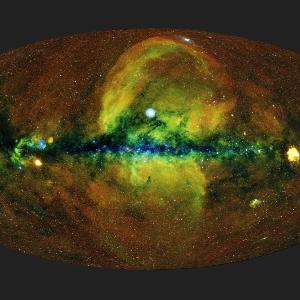Our deepest view of the X-ray sky
19 Jun 2020
The eROSITA telescope has provided a new, sharp view of hot and energetic processes across the Universe. LMU teams of physicists were also involved in the scientific preparation.
19 Jun 2020
The eROSITA telescope has provided a new, sharp view of hot and energetic processes across the Universe. LMU teams of physicists were also involved in the scientific preparation.

The bright blue point source in the middle of the image is the Vela pulsar. | © Peter Predehl, Werner Becker (MPE), Davide Mella
Over the course of 182 days, the eROSITA X-ray telescope onboard SRG has completed its first full sweep of the sky. This new map of the hot, energetic universe contains more than one million objects, roughly doubling the number of known X-ray sources discovered over the 60-year history of X-ray astronomy. “This all-sky image completely changes the way we look at the energetic universe,” says Peter Predehl, the Principal Investigator of eROSITA at the Max Planck Institute for Extraterrestrial Physics (MPE). “We see such a wealth of detail - the beauty of the images is really stunning.”
Assembling the image has been a mammoth task. This first complete sky image from eROSITA is about 4 times deeper than the previous all-sky survey by the ROSAT telescope 30 years ago. Most of the new sources are active galactic nuclei at cosmological distances, marking the growth of gigantic black holes over cosmic time. Clusters of galaxies in the new map will be used to track the growth of cosmic structures and constrain cosmological parameters. Closer to home, stars with hot coronae, binaries and supernova remnants dot our Galaxy, and we now have a complete map of the hot baryons in the Milky Way, something that can only be achieved with the 360-degree view provided by the eROSITA survey.
Research groups in the LMU Faculty of Physics have been involved in the preparation for eROSITA since 2009. The Cosmology and Structure Formation research group, led by Joseph Mohr, is responsible for the cross-identification of the X-ray identified galaxy clusters from the eROSITA sky survey with their optical galaxy counterparts, providing redshifts or distances to each of the thousands of newly discovered systems. The preparatory work has enabled the construction of the new galaxy cluster catalogs including redshifts in record time, with Matthias Klein providing the first version of the cluster catalog to the eROSITA collaboration within a week from the end of the survey. Other Cosmology and Structure Formation group members are focused on using gravitational lensing to measure the cluster masses and in contributing their expertise to the cosmological and astrophysical study of these systems.
The Physical Cosmology research group, led by Jochen Weller, plans to use the new cluster catalog to identify a new catalog of voids-- large empty regions of low density that mark the large scale structure of our Universe. Members of Andreas Burkert's Computational Astrophysics Group, including Klaus Dolag, focus on using their hydrodyanical simulations of structure formation to enable precise studies of the physical processes responsible for the formation and evolution of both the active galactic nuclei and the galaxy clusters. These LMU research groups all work in close collaboration with the rest of the eROSITA science team, located at MPE and the other eROSITA institutions within Germany.